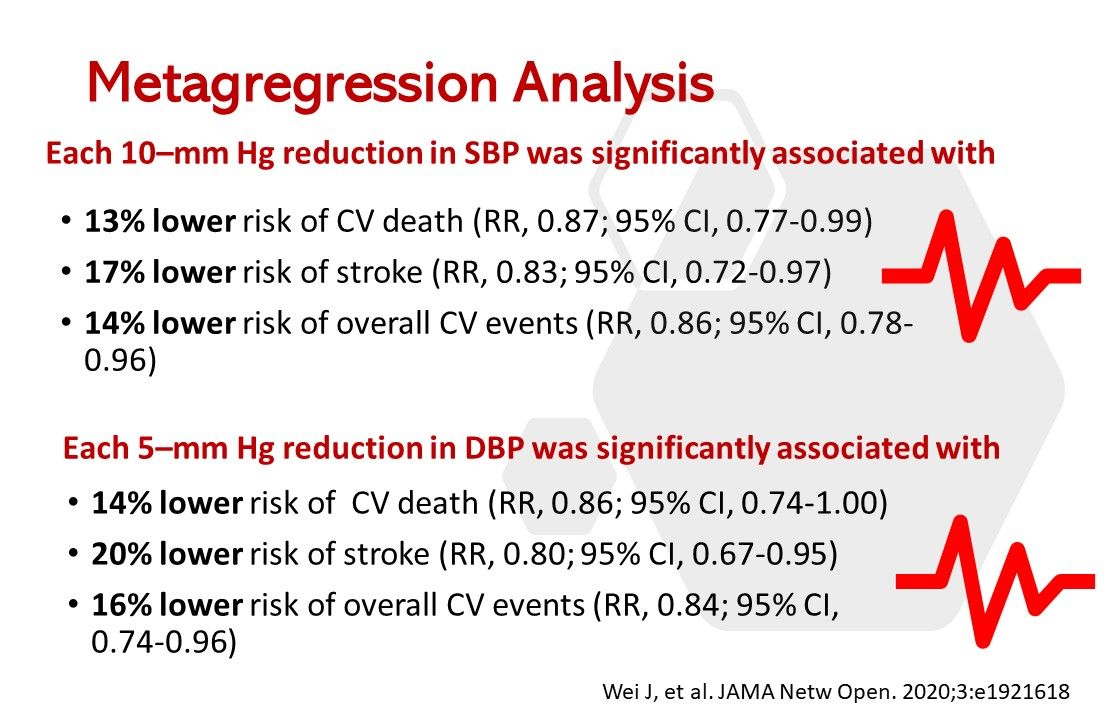- Clinical Technology
- Adult Immunization
- Hepatology
- Pediatric Immunization
- Screening
- Psychiatry
- Allergy
- Women's Health
- Cardiology
- Pediatrics
- Dermatology
- Endocrinology
- Pain Management
- Gastroenterology
- Infectious Disease
- Obesity Medicine
- Rheumatology
- Nephrology
- Neurology
- Pulmonology
Many BP Drug Classes, Similar Impact on CV Events
Antihypertension drugs deliver similar reduction in CV events, a new study finds. Message: Focus on reaching target BP, not on drug class.
Figure: Metaregerssion analysis results

The magnitude of blood pressure reduction rather than the class of drug used to achieve the result is most important in reducing cardiovascular (CV) events, according to a new systematic review.
The large meta-analysis (46 eligible trials, nearly 250 000 participants) found that each 10-mm Hg reduction in systolic blood pressure (SBP) and 5-mm Hg reduction in diastolic blood pressure (DBP) was significantly associated with a lower risk of CV death, stroke, and overall CV events, regardless of the class of medication used. The findings were published online Feb 21 in JAMA Network Open.
The researchers, led by Jingkai Wei, MSPH, PhD, of the department of epidemiology, Milken Institute School of Public Health, George Washington University, in Washington, DC, write that the drawback of previous meta-analyses of the efficacy of antihypertension drugs in reduction of CV events is that they have compared only 2 classes of medication; moreover, only 1 network meta-analysis compared different classes of BP drugs in preventing CV events and because it was published more than 15 years ago included BP medications that are used less frequently in contemporary treatment regimens.
Study scope
For the systematic review and network meta-analysis, data were pooled from 46 eligible clinical trials (248â¯887 total participants with a mean [SD] age of 65.6 [5.8] years; 52.8% men). Mean (SD) baseline SBP was 161.3 (13.6) mm Hg (range, 129-195 mm Hg). Participants had hypertension but no significant comorbidities.
There were 15 studies of angiotensin converting enzyme (ACE) inhibitors, 15; 23 of dihydropyridine calcium-channel blockers (DH CCBs); 4 of non-DH CCBs; 8 of beta blockers; 12 of angiotensin-receptor blockers (ARBs); and, 13 of thiazide diuretics.
The primary outcome was first-in-trial CV events, including CV death, myocardial infarction, stroke, and revascularization.
Mean follow-up was 3.7 years; overall, participants had mean reductions of 18.0 mm Hg in SBP and 10.1 mm Hg in DBP. The risk of CV events was 11.5%.
Comparative efficacy
In the network meta-analysis, compared with placebo, ACE inhibitors, DH CCBs, and thiazide diuretics were found similarly effective in reducing overall CV events (25%), CV death (20%), and stroke (35%); ACE inhibitors were reported to be the most effective in reducing the risk of myocardial infarction (28%); and diuretics most effective in reducing revascularization (33%). Each medication class was linked with a 17% to 29% lower risk of overall CV events.
In the metaregression analyses, each 10-mm reduction in SBP was significantly associated with a 13% lower risk of CV death, 17% lower risk of stroke, and 14% lower risk of overall CV events. Each 5-mm reduction in DBP was significantly associated with 14% lower risk of CV death, 20% lower risk of stroke, and 16% lower risk of overall CV events. (Figure)
Wei and colleagues write that clinicians and patients should share the decision-making process to identify which medication is best tolerated to reduce hypertension to target levels in order to prevent future CV events.
Implications for practice
The current data suggest that all available drug classes are effective and that the most important element of therapy is reduction of risk. Given the increased estimate in the number of people with hypertension resulting from 2017 revisions to the American College of Cardiology and the American Heart Association hypertension guidelines, it is even more important that clinicians carefully consider optimal first line treatment for hypertension.
A primary limitation of the study, according to the authors writing in the discussion, is the absence of studies that compare the efficacy of combinations of antihypertensive agents – a shortcoming, they note, of the body of literature available. They note that future studies should facilitate these comparisons.
For more breaking news from Patient Care® Online:→Subscribe to our Newsletter
And, stay in touch around the clock:→Like us on Facebook →Follow us on Twitter →Follow us on LinkedIn
